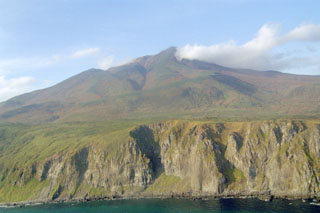Report on Sashiusudake [Baransky] (Japan - administered by Russia) — December 1992
Bulletin of the Global Volcanism Network, vol. 17, no. 12 (December 1992)
Managing Editor: Lindsay McClelland.
Sashiusudake [Baransky] (Japan - administered by Russia) 1991 hydrothermal explosion near geothermal drillhole
Please cite this report as:
Global Volcanism Program, 1992. Report on Sashiusudake [Baransky] (Japan - administered by Russia) (McClelland, L., ed.). Bulletin of the Global Volcanism Network, 17:12. Smithsonian Institution. https://doi.org/10.5479/si.GVP.BGVN199212-290080
Sashiusudake [Baransky]
Japan - administered by Russia
45.1°N, 148.019°E; summit elev. 1125 m
All times are local (unless otherwise noted)
Many hot and boiling mineralized springs are active near Baransky. Geothermal surveys have been carried out in a zone 2-4 km SW of the volcano, and a geothermal station is being built there. Temperature data from several boreholes show a strong increase in 1989, 4-5 months before the eruption of Ivan Grozny, 13 km SW. Temperatures decreased after the eruption. Gas composition (table 1), temperature, and location of fumaroles in the SW-flank explosion crater remained unchanged in 1990-91.
Table 1. Composition of gases from the Baransky area: fumaroles in the SW-flank explosion crater (samples 1-4); the bottom of the Kipyaschaya River drainage (6); geothermal drillholes (7-8). Analyses by U.A. Taran and U.A. Ignatorich. Data courtesy of G. Steinberg.
| Sample | 1 | 2 | 3 | 4 | 5 | 6 | 7 | 8 |
| Temp. (°C) | 100 | 99 | 100 | 101 | 98 | 61 | 170 | 47 |
| H2O (mole %) | 75.5 | 85.8 | 97.01 | 98.7 | 99.1 | -- | 99.94 | -- |
| Volume % of dry gas | ||||||||
| CO2 | 92.45 | 94.20 | 94.20 | 91.20 | 58.24 | 33.00 | 70.0 | 88.0 |
| H2S | 5.71 | 4.60 | 4.51 | 6.00 | 33.0 | 2.2 | 15.1 | 0 |
| SO2 | 0.18 | 0.15 | -- | -- | -- | -- | -- | -- |
| H2 | 0.001 | 0.002 | 0.006 | 0.001 | 0.064 | 0.001 | 9.7 | 0.003 |
| CH4 | 0.073 | 0.070 | 0.10 | 0.01 | 1.27 | 1.20 | 3.3 | 0.03 |
| HCl | 0.01 | 0 | 0 | 0 | 0.01 | -- | -- | -- |
| N2 | 1.22 | 1.18 | 1.20 | 2.10 | 7.43 | 63.0 | 11.0 | 12.0 |
An exploration well into a zone of hot water 4.5 km SW of the summit (in the Kipyaschaya River valley) was drilled in the summer of 1991. Drilling was temporarily halted in early August, but no casing was installed. Two weeks later, a hydrothermal explosion occurred ~50 m upslope, forming a crater >10 m in diameter. A mixture of vapor, water, and a large quantity of rock fragments was erupted for several days, destroying vegetation within 50 m. The explosion was believed to have occurred when hot water moved up the borehole after drilling ceased, and escaped through its uncased walls into a permeable fissured zone near the surface.
Geological Summary. The Sashiusudake (also known as Baransky) volcanic complex along the Pacific coast in the central part of Iturup Island consists of an eroded Pleistocene volcano that is capped by a Holocene stratovolcano. A young summit lava dome is cut by a NW-trending chain of small explosion craters. A group of flank cones farther to the NW with a similar NW-SE orientation is partially surrounded by lava flows from the central crater of the andesitic-dacitic volcano. Lava flows from descended 4-5 km SE to reach the Pacific Ocean along a broad front. The only historical eruption occurred in 1951, when local inhabitants reported weak explosive activity at the summit. Strong solfataric activity continues from the summit and several flank craters, and the SW flank geothermal field contains hot springs and geysers. A small hydrothermal explosion took place in 1992 at an exploratory well in the SW-flank geothermal field.
Information Contacts: G. Steinberg, Yuzhno-Sakhalinsk.

